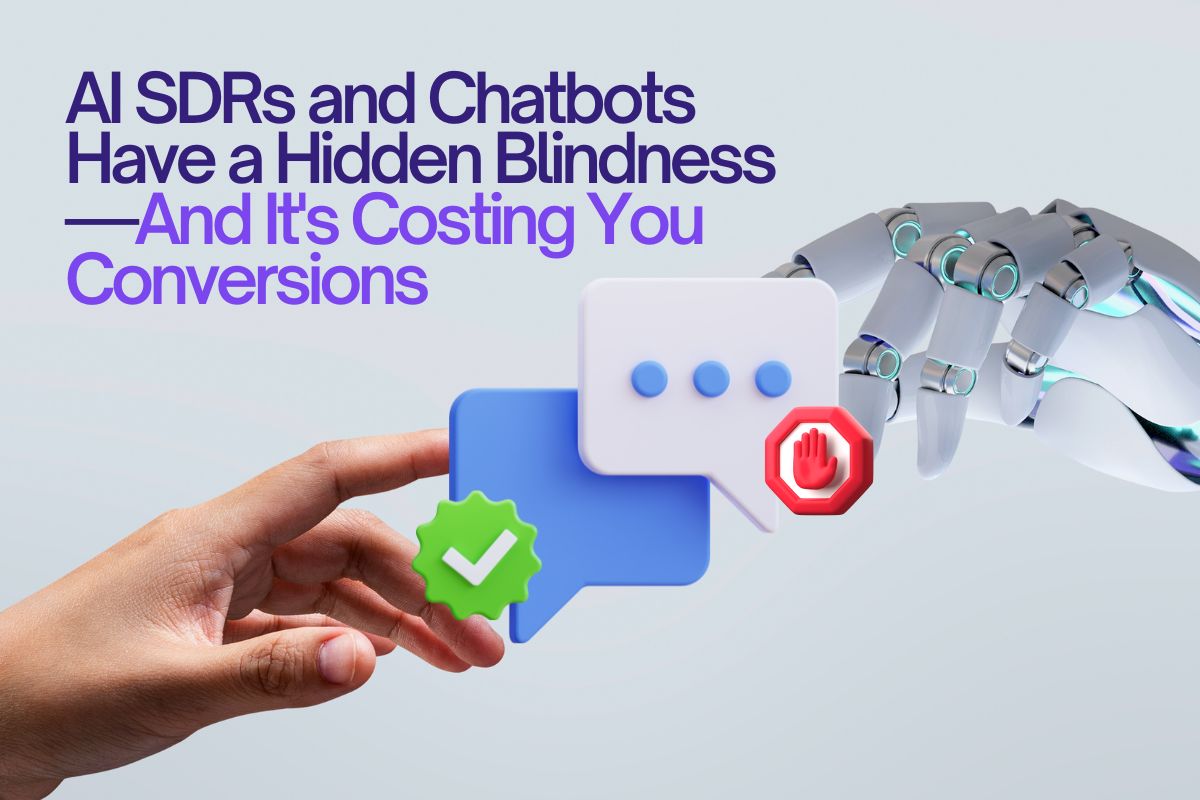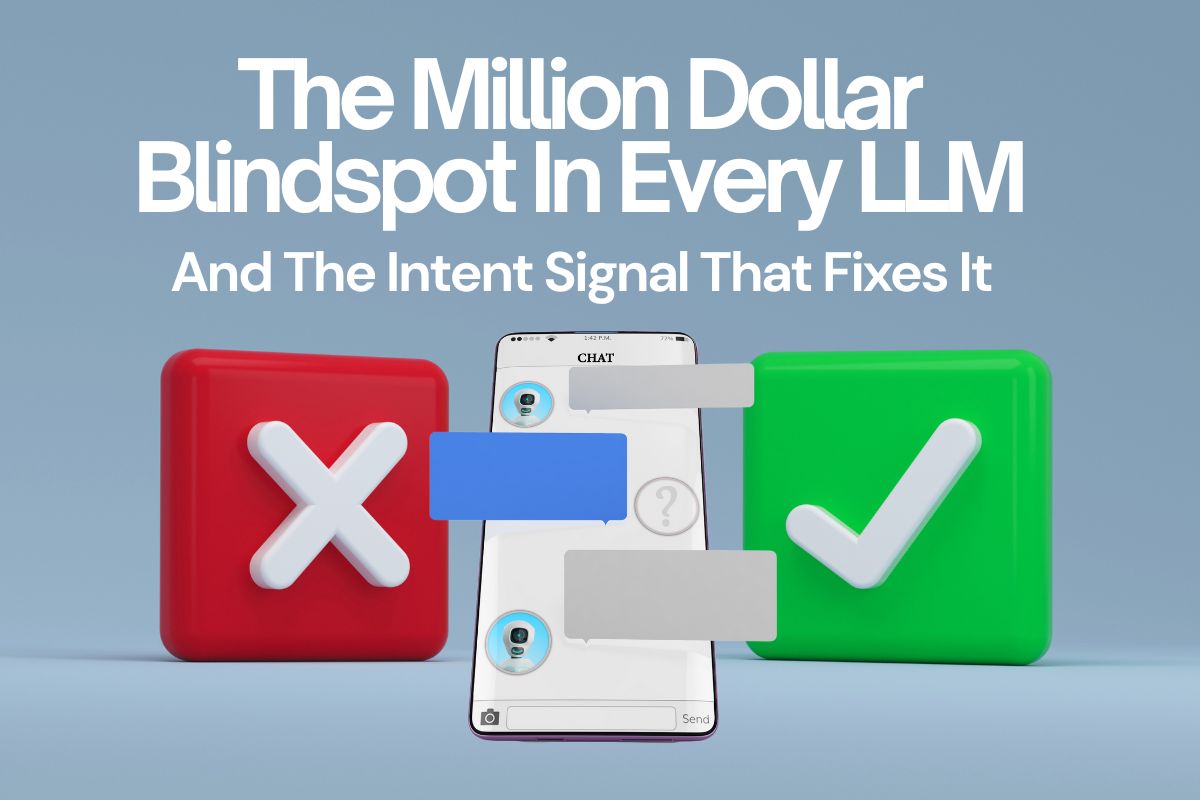AI is Driving Rapid Changes in GTM: So Why is it Failing?
The AI revolution in go-to-market is in full sprint.
From SDR copilots to chatbots to autonomous agents, every team is racing to deploy something “intelligent” into their sales and marketing stack.
On the surface, it feels like a leap forward — where efficiency finally scales, where every interaction can be personalized, and where pipeline grows on autopilot.
But there’s a huge catch.
According to an MIT study, 95% of enterprise AI pilots fail — not because the AI itself is flawed, but because the data feeding it is.
AI doesn’t invent wisdom out of thin air. It amplifies whatever signals it receives. And if those signals are inaccurate, biased, or incomplete, AI simply automates bad judgment at scale.
In other words: Garbage in → Garbage out (but faster, and at scale).
The problem isn’t that AI is overhyped. It’s that GTM teams are feeding it with low quality information from the very start.
This poisons every sales motion, every marketing play, and every other step in the GTM engine.

And the most important data feeding those GTM engines — the one that determines who to target, when to engage, and how to respond — is intent data.
The Signal Accuracy Problem Undermining AI
Across the industry, intent signals are accurate less than 20% of the time. Leading research confirms this problem.
An MIT study (Neumann, Tucker, & Subramanyam) found that off-the-shelf intent data segments performed “no better at reaching the right person than random prospecting”.
Forrester’s report (Brett Kahnke) echoed this conclusion: “Despite all the benefits of intent data, too often the reality doesn’t meet the expectations. This is particularly true in sales.”
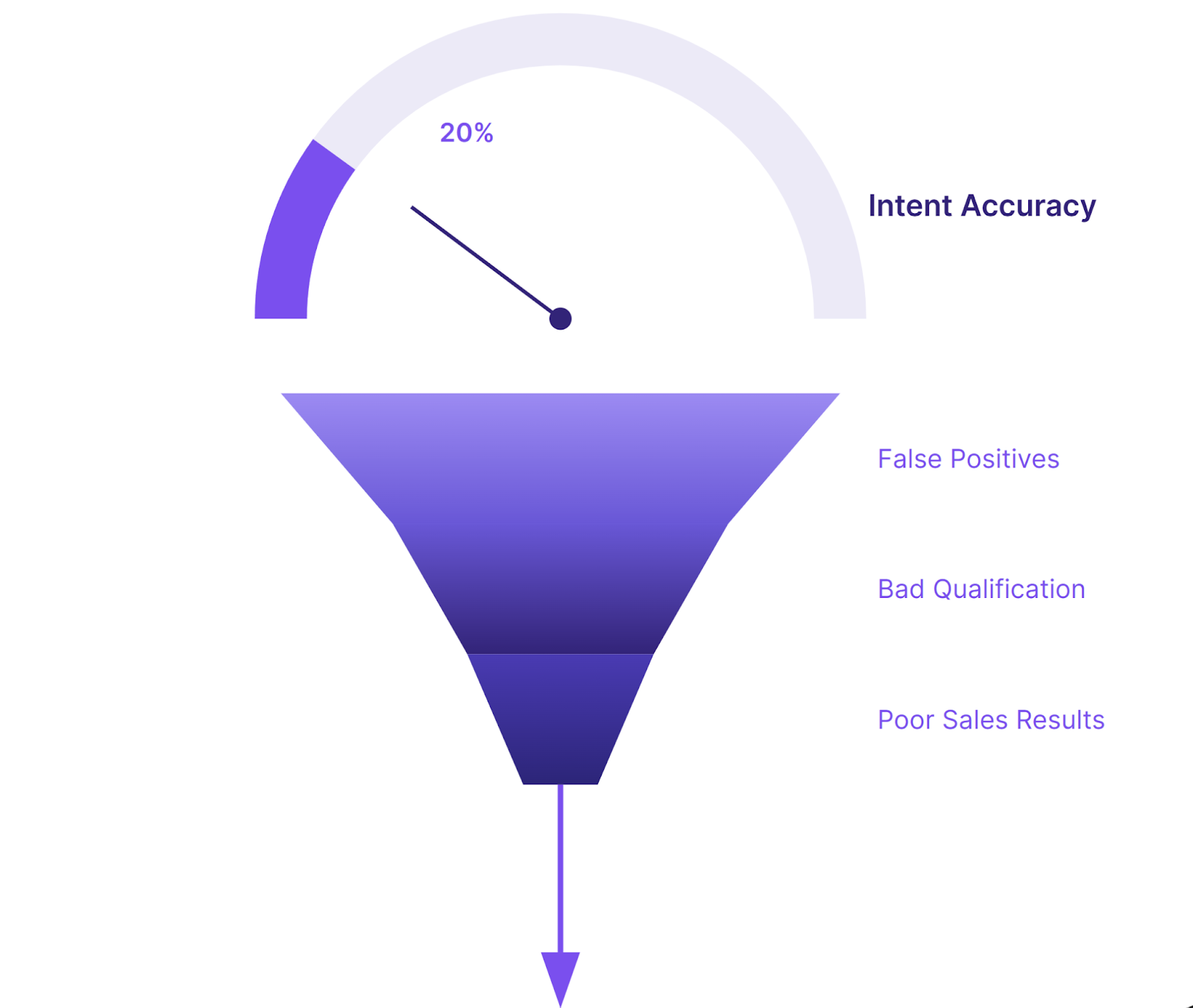
That means over 80% of the time, your AI SDRs, chat tools, and automated workflows are acting on noise, not truth.
Let’s break down the sources of that distortion:
- Identity-Based Signals
These tools focus on who website visitors are using ID Matching or ID Reveal. But a visitor’s name or company tells you who they are, not what their buying intent is. And these systems miss ~70% of your website traffic that remains anonymous. - Rules-Based Signals
Specific Page views, email opens, form fills — these surface-level metrics are often biased, sparse, mistaken for causation, and misaligned with real purchase intent. They typically apply arbitrary weighting to individual events rather than analyzing the pattern of behaviors that truly indicate buying readiness. In other words, they describe simple activity, not complex buying behaviour. For example, our data shows that up to 94% of Pricing Page visitors are not high-intent, yet most tools use this as the primary indicator. - Third-Party Signals
Keyword searches, content consumption, and review site visits provide a tiny fragmented view of external behavior, often dated or irrelevant by the time they reach your systems. They may show signs of life, but they’re not precise enough to drive your GTM.
This all leads to AI agents learning from inaccurate, low quality signals — and acting on them, leading to compounding costs and losses along the GTM chain.
Example: Why AI SDRs and Chatbots Still Miss the Mark
On paper, AI SDRs and chat platforms promise a dream scenario: instant responses, 24/7 qualification, and seamless routing.
But in practice, they rely on the same inaccurate signals that have plagued GTM for years.
That’s why so many teams find their “smart” chatbots flooding calendars with unqualified meetings or overwhelming sales reps with noise. Others go in the opposite direction, over-automating the experience until real buyers slip away, or adding friction to the experience in order to qualify them (all while trying to infer buying intent from conversation).
The balance between “too hot” and “too cold” is delicate:
- Too Hot:
Route as many visitors to sales as possible and you burn precious sales resource time on non-buyers while real opportunities languish. - Too Cold:
Automate everything with AI and you’ll frustrate genuine prospects who are ready to engage but forced through qualification questions and not getting to a human fast enough.
Both extremes cost conversions. Both come from the same root problem: the system doesn’t know who’s actually ready to buy.
Here’s an example:
A visitor might sound “ready to buy” because they ask a pricing or demo question — but they could just be researching, comparing, trying to check the box for an RFP, or even looking for support. Without context, the AI treats every question like a buying signal and tries to push for a conversion that isn’t there. That’s how you lose trust (and future opportunities).
It goes the other way too. Some visitors look “technical” — asking integration or setup questions — when they’re actually deep in the decision stage and trying to confirm fit. Without accurate intent, the AI stays in qualification mode too long, and the deal slips away.
That’s where Lift AI’s ONE Signal changes everything.
The ONE Accurate Signal That Brings AI SDRs and Chat to Life
Using proprietary Micro-Behavioral Analysis™, Lift AI predicts the buying intent of every single visitor on your website with over 85% accuracy.
Not hoping for 20% accuracy. Not identity-based. Not rules-based. Not third party guesswork.
Eighty-five percent accuracy. And we can report on model accuracy with our Buyer Intent Accuracy Dashboard, any time, any day.
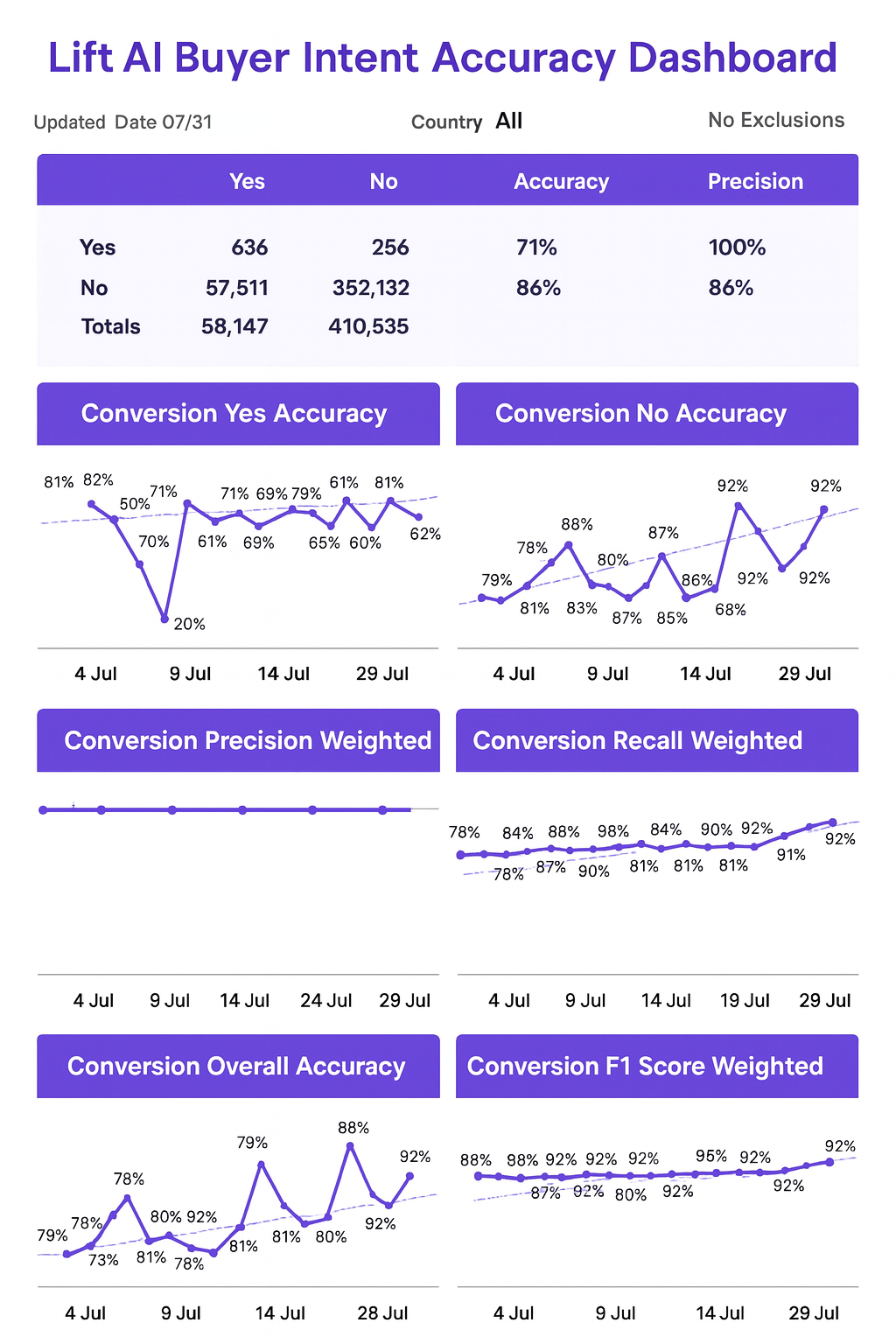
That means your AI SDRs, chat tools, and GTM systems finally get the context they need before they act. Lift AI doesn’t replace AI them — it unlocks the potential in them.
Feed Lift AI’s signal into your AI SDR or chat system and watch what happens:
Here’s how you put it into practice:
Playbook 1, Step 1 — Converting More Hand Raisers in Real Time
Most of your investment in AI SDRs, Chat, and Form Optimization tools is to drive more hand-raiser conversions.
Lift AI ensures you find and engage high intent visitors with the best possible experience to maximize those conversions before the visitor leaves your website.
When it comes to AI SDRs and Chat specifically, Lift AI enables a more effective conversation by aligning the whole experience to where the customer is at in their buying journey at that moment.
Example: Hooks and Timing Before Conversations
You start conversations when (and only when) it matters. And the opening message is more likely to connect, because it is tailored to their intent level at that exact moment.
- ❌ Without Lift AI: Wrong Hook, Wrong Time Visited Product Page, 40 Seconds On Site: “Hi there! 👋 Need help finding something?”
→ Generic and forgettable. Treats every visitor the same. - ✅ With Lift AI: Predictive Personlization High-Intent (Score 88): “Looks like you’re exploring enterprise features — want to see a quick demo?”
Low-Intent (Score 18): [Silent monitoring, no interruption to experience.]
That single change — from prescriptive to predictive — transforms the experience and conversion efficiency.
Example: Friction During Conversations
Lift AI ensures you don’t waste time asking qualification questions that could be skipped, adding friction to the experience, or trying to infer intent based on conversation rather than behavior.
- ❌ Without Lift AI: Qualification Friction
“What’s your company size? Industry? Budget?”
→ Feels like an interrogation. Adds friction. Bad experience. - ✅ With Lift AI: Fast-tracked Experiences High-Intent (Score 85): “Let’s get you on our calendar.”
Mid-Intent (Score 54): “Here’s a quick ROI calculator.”
Low-Intent (Score 23): “Here’s a guide that compares our plans.”
Example: Misintepretation During Conversations
Pretend a visitor asks “Can you show me pricing?”
Their behavior so far: Came from a blog, skimmed high-level content, and spent more time in educational sections — a research pattern with low buying readiness.
- ❌ Without Lift AI:
"Absolutely! I'd be happy to walk you through our pricing and set up a demo. What's your email and I can send you a link?"
→ Too aggressive. Visitor bounces. Wasted conversation. - ✅ With Lift AI
"Great question! Since you're comparing options, I put together this 2-minute pricing comparison guide that shows how we stack up. It might help as you evaluate. Want me to send it over?
→ Helpful, educational. Builds trust without pressure.
Case Study: Boomi’s 2x AI SDR Conversions
Boomi used Lift AI to power its conversational AI platform. By routing high-intent visitors directly to live sales reps while nurturing mid- and low-intent ones via the AI, they doubled SDR conversations to pipeline and doubled opportunities generated in the quarter.
Case Study: Fluke Biomedical’s 345% More Revenue Per Visitor
Fluke combined Lift AI with chat to guide the experience for high, mid, and low-intent visitors. They came to realize that visitors asking for a pricing quote when scored as low intent by Lift AI were almost always a waste of time, and were automatically deflected to automation. The result: 345% more revenue per visitor.
Case Study: Truckstop
Truckstop targeted high-intent website visitors using their chat tool, routing high intent visitors to live agents in real-time who have the best chance of converting compared to chatbots. This resulted in a 3x higher conversion rate for high-intent traffic vs. general traffic (9.72% vs. 3.28%),while cutting the sales cycle in half, and increased bookings from $56k a month to $286k a month in 5 month
Playbook, Step 2 — Prioritize & Personalize Hand Raiser Follow Up
Even after a visitor raises their hand — fills out a form, engages in chat, or requests a demo — not all leads deserve equal attention.
This is where most CRMs and lead scoring systems break down.
They assume every hand raiser is worth chasing, and sales teams end up wasting precious hours on low-intent leads.
Lift AI changes that equation by providing real intent scores that feed directly into your CRM, marketing automation, or enrichment systems — instantly sharpening prioritization.
Example: After Hand Raising - Faster, Smarter Hand-offs
- High Intent: Push straight into sales and meeting flows, route to the fastest available rep.
- Mid Intent: Enter automated nurture sequences or handled by SDRs after further qualification.
- Low Intent: Deflect from sales resources. Stay warm through lighter educational outreach without wasting sales time.
Case Study: RealVNC
RealVNC analyzed 15,364 form fills over 30 days.
9,148 of them (nearly 60%) were low intent.
And they only generated only 8% of total revenue.
This was an immediate, clear sign that not all hand raisers are worth sales time.
Using Lift AI, RealVNC was able to deflect or deprioritize those low-intent leads, making a sudden impact on their efficiency.
It also freed their sales team to focus on the hidden, high-intent prospects who never filled a form or raised their hand, but were already in their CRM from prior engagements.
In fact, just 190 of those high-intent accounts uncovered by Lift AI were worth 2.34× more revenue than the entire 9,148 low-intent form fills combined.
That’s the definition of efficiency: doing less outreach, but creating more pipeline. All from existing leads on their website and CRM right now.
The New GTM Equation for AI SDRs and Chat — Accuracy + Full Coverage + Scale = Growth
AI agents are here to stay.
They run 24/7 and will handle more outreach, qualification, and engagement than ever before.
But their success — and yours — depends entirely on what intent data or signals they’re fed.
Without Lift AI, AI tools act on flawed, incomplete signals:
- They chase false positives.
- They automate friction.
- They amplify inefficiency.
With Lift AI, every GTM motion begins with accuracy:
- 85%+ Proven Accuracy: Real, behavioral predictions, not guesswork.
- 100% Coverage: Works on every visitor, both anonymous or known.
- Real-Time Scoring: Pre-conversation intelligence that guides perfect timing.
- Rapid ROI: Measurable results in as little as 30 days.
In this AI-powered GTM era, the losers will create more spend and activity, but not more conversions.
Meanwhile, the winners will unlock hidden pipeline and accelerate GTM revenue in short order.
Lift AI gives GTM teams that truth — the ONE Signal that turns noise into opportunity at every step — not just through AI SDRs, Chat, and Form Fills.
In fact, there are 2 other playbooks not covered in this article for surfacing identified and anonymous buyers that don’t raise their hand, each with distinct steps that you can use to unlock even more opportunities right now. Read more here.
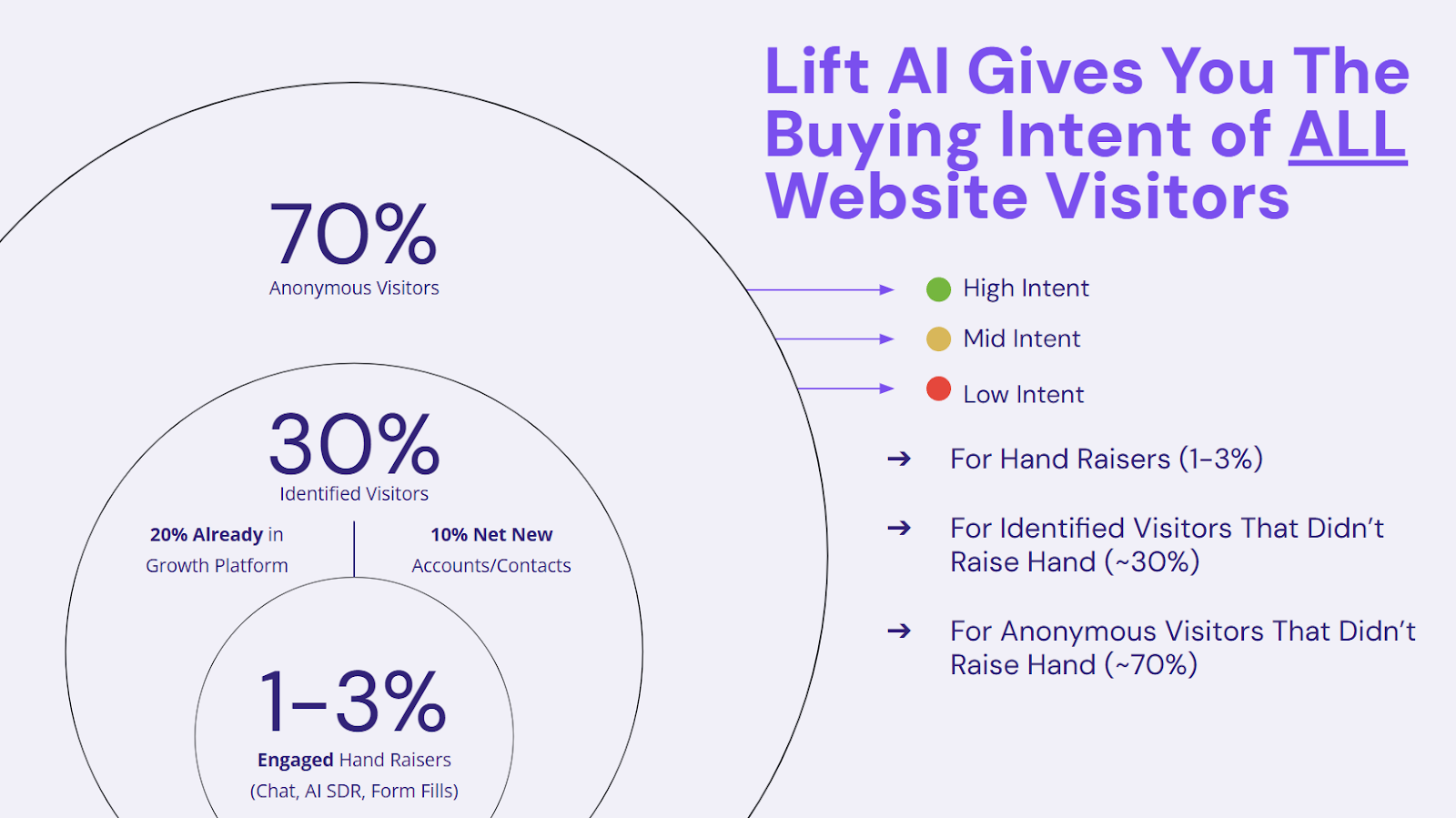
So you don’t need another AI tool — you need better data powering the ones you already have. Lift AI can be installed in minutes and start scoring 100% of your website visitors instantly, uncovering hidden buyers and proving ROI within 30 days. Start your free trial today and see how the ONE Signal transforms your GTM from guesswork into growth — guaranteed.

